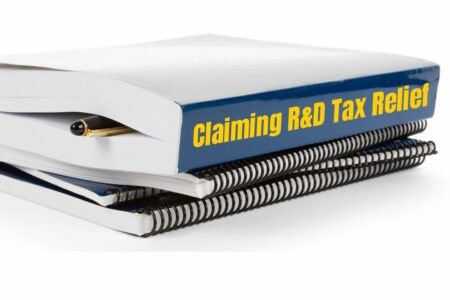The most significant change lies in HMRC’s increased scrutiny of claims. Although this has made the claims process more difficult across the board, it has also offered us a much clearer picture of how HMRC tests claims using compliance checks. HMRC have also mandated what information must be submitted digitally for every claim (from 8th August 2023), giving further insight into accepted methodology.
This all presents an ideal opportunity for industry professionals to assess their claim methodology, check their understanding of the system, and execute a plan which safeguards their income stream for years to come.
Step 1 – Establishing Eligibility
Understanding how your client qualifies for R&D tax relief starts with an eligibility conversation. This is your opportunity to emphasise that HMRC have a very specific definition for R&D which must be adhered to. Make sure to give your client the link to this definition, and direct them to the BEIS guidelines or DSIT guidelines (depending on the claim period). During the course of a compliance check, the client may be asked if they were provided with this information by HMRC.
The key messages to cover in your eligibility conversation are:
- What is the specific field of science or technology?
- Does the company have a competent professional working in the field outlined in (1)?
- Did the competent professional research the industry baseline and can this be evidenced
- What is the advance in technology? Is this advance an industry advance or the company improving its own capabilities?
- Did technological uncertainties exist to prevent the company from making the advance
- Despite trying anything known in the industry to resolve the technological uncertainties, did some still remain which took time and resources to resolve?
Having a thorough conversation with prospective clients helps to prevent unforeseen complications cropping up further down the line. It also informs each step of the claims process, and gives a more rounded picture of what the claim looks like from the get-go.
Step 2 – Claim documentation
The second step is crucial, and one which might save you the most headaches in the long run. Documentation. Comprehensive, detailed notes from each stage of the project are an invaluable resource in submission and potential defence of a claim.
Taking each point in turn and in as much detail as possible, capture:
The field of science or technology.
For example, if the R&D work involves an advance in plastics describe this as polymer engineering. The client should be able to identify this.
The details of the Competent Professional involved in the project.
HMRC will test if there is a “Competent Professional working in the field”. Look at Corporate Intangibles Research and Development Manual – CIRD 81300 for HMRC’s definition of a Competent Professional and ensure this condition is met and can be evidenced.
How the industry baseline was ascertained. Examples of the types of research could involve:
- Academic & industry literature, research papers, and publications,
- Details of emerging technologies / latest innovations,
- Companies which are key players and competitors,
- Technological offerings of competitors and their limitations
- Data on technological usage, preference, and needs,
- Attendance at industry specific trade shows/conferences/exhibitions,
- Industry specific regulations, standards, and compliance requirements,
- Analysis to understand patents related to the industry’s technology, areas of innovation, and potential disruptors,
- How the advance in technology would be affected by the above factors.
With this comprehensive research the industry baseline can be concisely explained to HMRC, and if tested by compliance check then more detailed evidence can be provided. Without this, it is difficult to see where the advance is, and HMRC can challenge a claim on the basis that there is no qualifying R&D.
What the advance in technology is in clear and concise terms.
Describe this section using figures and statistics. For example:
a company used an alternative, naturally occurring ingredient as part of a new polymer mix. The strength of the extruded new material was increased by 20% compared to the equivalent synthetic industry standard material.
Description of the technological uncertainties.
Without an adequately explained baseline and advance, HMRC can easily reject a claim. Being clear and concise and following a structure for each technological uncertainty makes it easy for HMRC to assess the validity of the claim.
Without using jargon, explain what the problem is and how it prevented the advance from being made. You should also explain why the uncertainty was difficult to resolve and why it was complex. At this point it’s useful to mention the baseline industry-wide knowledge and information that was available and how this helped. Then, move on to show the limitations of this knowledge and how its application did not resolve the problem.
Step 3 – Checking knowledge & understanding
Reviewing your knowledge and claim methodology is the last step in the process, but it is the most important in ensuring the longevity of your business. HMRC is the most watchful they’ve ever been, and they are hands-on with the scheme until they get it to a spot that they’re happy with. Adapting your approach now can set you up for many days to come when HMRC eventually shifts their focus to another area.
Engaging with a training course or platform like the one we offer at The R&D Community is the most straightforward way to do this. We stay on top of all changes to the scheme and release timely training courses that quickly get you up to speed. Members find our content easy to digest and effective at building lasting knowledge and habits. That isn’t to mention all the other benefits offered as part of membership.
Our ultimate goal is to raise standards in R&D tax relief, thereby ensuring the longevity of the scheme and the innovation it supports in British businesses. Our next stepping stone on the way to that goal is provision of a professional certification in R&D tax relief. This will allow advisers to easily distinguish themselves as responsible providers of R&D tax relief.
If that sounds like something you want to get involved with, learn more about how to become a member of The R&D Community. If you just want to come along for the ride, our newsletter offers regular updates on the latest industry news and developments.





